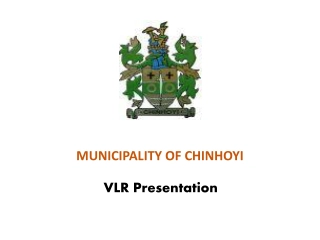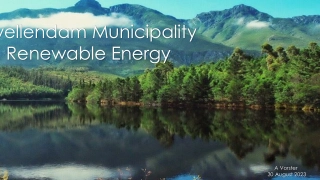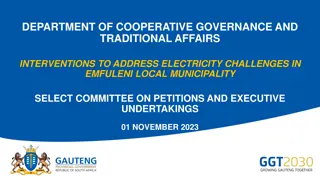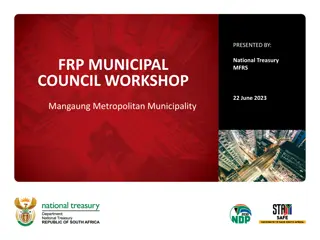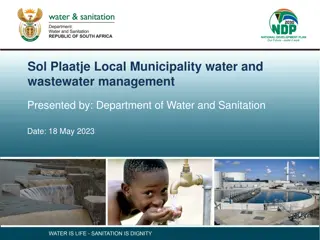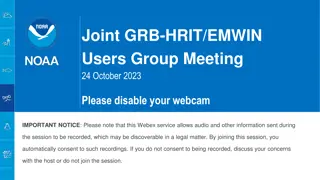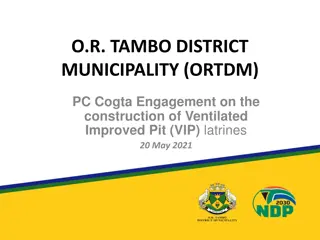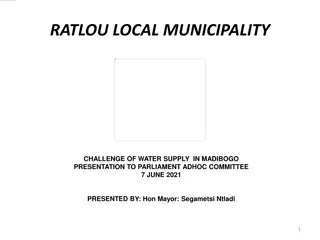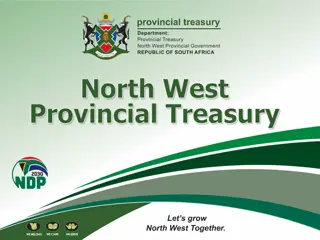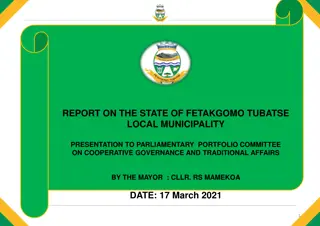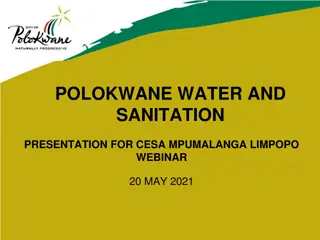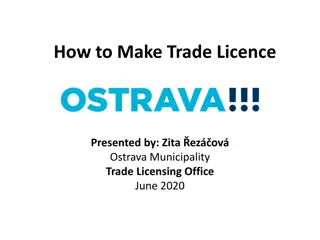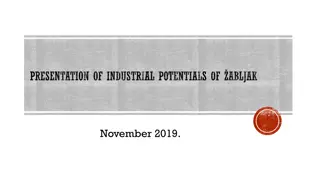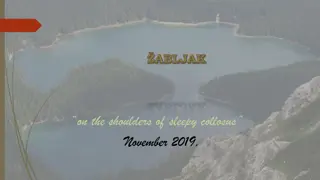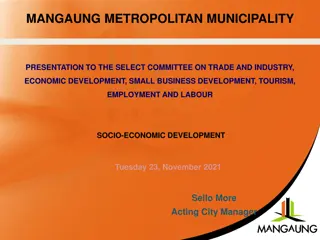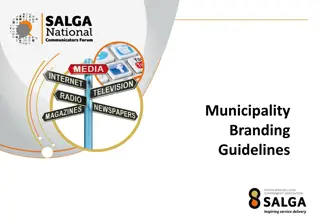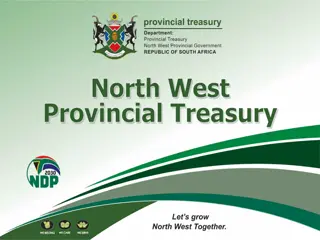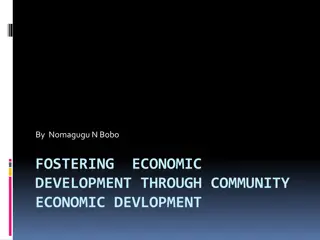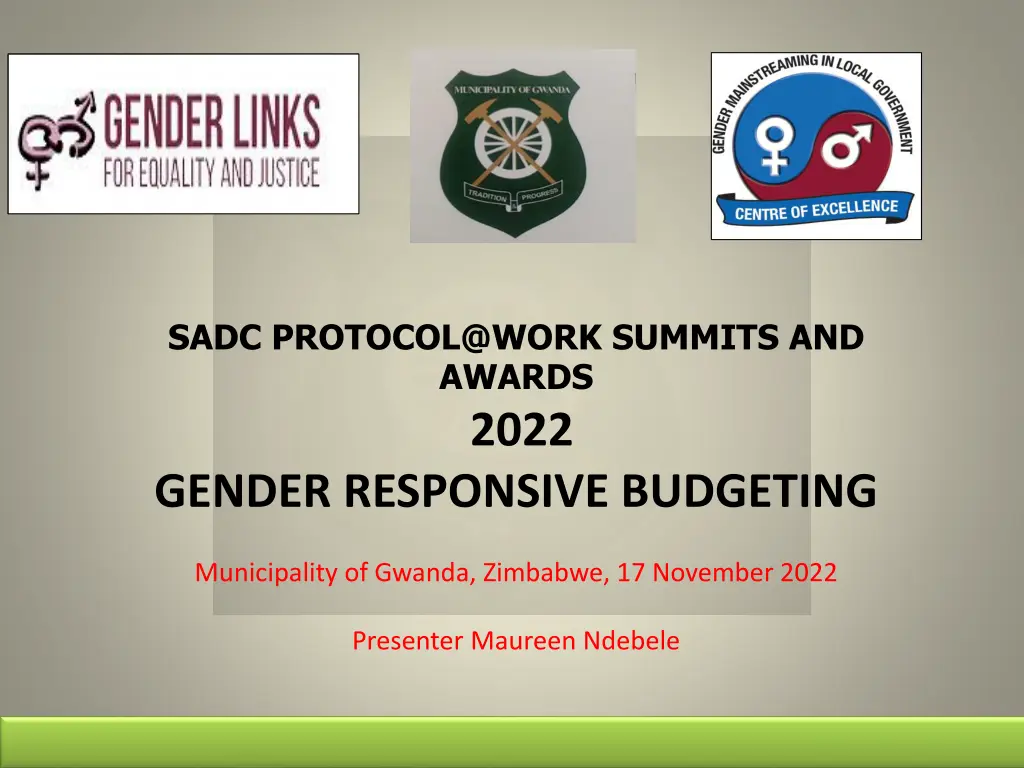
Gender-Responsive Budgeting at Municipality of Gwanda, Zimbabwe 2022
Explore how the Municipality of Gwanda, Zimbabwe, implements gender-responsive budgeting in their 2022 budget, focusing on policies, the budget process, and funding sources. Learn about stakeholder involvement, consultation methods, and key characteristics of the municipality.
Download Presentation

Please find below an Image/Link to download the presentation.
The content on the website is provided AS IS for your information and personal use only. It may not be sold, licensed, or shared on other websites without obtaining consent from the author. If you encounter any issues during the download, it is possible that the publisher has removed the file from their server.
You are allowed to download the files provided on this website for personal or commercial use, subject to the condition that they are used lawfully. All files are the property of their respective owners.
The content on the website is provided AS IS for your information and personal use only. It may not be sold, licensed, or shared on other websites without obtaining consent from the author.
E N D
Presentation Transcript
SADC PROTOCOL@WORK SUMMITS AND AWARDS 2022 GENDER RESPONSIVE BUDGETING Municipality of Gwanda, Zimbabwe, 17 November 2022 Presenter Maureen Ndebele
OVERVIEW COUNTRY ZIMBABWE COUNCIL (HUB/SPOKE) SPOKE GENDER CHAMPION NAPPY MOYO GENDER FOCAL PERSON MARILYN NYONI Latest score (year) --- Expenditure % Gender Specific Income Budget (YEAR) 2022 US$38 350 1% US$38 380 Women Men Total % Women Council 1 9 10 10% Management 2 3 5 40% Council staff overall 64 116 180 36% Population served 27143 Key characteristics The municipality has 10 wards. A total population of 27 143 of which 12 773 are male and 14 370 are females. Females constitute 52% of the total population Total number of households is 8 375
I. POLICY FRAMEWORK Photo of the Gender Policy Gender provisions and policies that guide the Council budget National Gender Policy Constitution of Zimbabwe National Development Strategy 1 Council gender policy Youth and women are a major stakeholder under special groups on budget consultations as enunciated in the gender policy
II. THE BUDGET PROCESS Detail Evidence Photos or video of budget consultation Council integrated gender and inclusion in budget planning through consultative budgeting. Stakeholders were involved from the strategic planning process to setting annual priorities in budgeting women and youth being the major stakeholder Budget consultation methodology Civic engagements - council considered special groups which include youths, women, PWDs among others. Data was disaggregated to establish the number and the percentage of women participation in decision making To ensure that budget consultation process was inclusive, council Advertised in the local newspaper Public notices Public announcements Formal invitation to leadership e.g residents associations, business associations etc
II. THE BUDGET PROCESS Detail Evidence Time, venue and meeting strategies used to ensure inclusion Women consultation Time: 1000am Venue: Council Chamber Women were consulted midmorning to ensure that they attend in numbers after completing their usual household chores and knock off on time Other groups Time: 1600pm Venue: Ward center Invitation and discussion papers were sent on specific whatsup groups to ensure no one is left out
III. REVENUE Funding sources Internal 16 525 063 92% External 1 466 076 8% Sources of Revenue How did gender considerations informed decisions concerning the budgeting of revenue? Women raised their priorities as follows, accommodation, water, sanitation, clinics, schools, quota on allocation and improvement of business environment for SMEs. All these were taken into consideration and set for implementation in 2023 financial year. These priorities also affect men even through the order of priority was not the same How were these decisions influenced by budget consultations, in particular the views of women? Priorities were set taking into consideration all special groups which include women youth, PLWD, Business community, vendors, residents etc Issues raised include GBV, high crime rate, drug abuse, poor resource base 8% 92% Internal External Is any of the external financing specifically targeted at gender? Gender mainstreaming issue are mainly funded by internal sources, however, there are projects like schools and clinics which are mainly financed by external sources. These came as priorities in women consultation
IV. EXPENDITURE Council gender budget Gender management system Gender Management System US$15 384 Human capital US$12 446 Employment expenditure US$2 000 Gender-specific programmes US$5 000 Mainstream programmes US$3 000 Other US$1 000 Total US$38 830 2% 8% 13% 40% 5% equity-related 32% Gender management system Employment expenditure Employment equity related expenditure Gender spec ific programming Mainstraem programmes Other
IV. EXPENDITURE Type of Expenditure Amount UUS$ Proportion (%) Gender Management System (GMS) $15 384 40% Employment expenditure (Human Capital Expenditure) $12 446 32% Employment equity related expenditure $2 000 5% Gender Specific Programming $5 000 13% Mainstream Programmes $3 000 8% Other $1 000 2% Total $38 830 100%
IV. EXPENDITURE- GMS Gender Management System Gender Committee Gender Focal Person Gender Champion GMS activities budgeted for; Committee meetings Spoke activities Exhibitions Training Policy formulation Exchange visits, Office equipment Stationery This budget is found under governance and administration
IV. Gender Specific expenditure What gender-specific programmes does the council have? Equal access to education and health Property ownership Employment Business ownership Where are these budget lines found? Are they visible? Governance and administration Proportion of the council budget allocated for gender-specific programming 1% How were these programmes/ projects informed by budget consultations Women raised their concerns and priorities which were taken into consideration to address women specific needs which include improved access to health and education, water, sanitation, accommodation How are the gender-specific projects helping to promote gender equality and women s empowerment? This assisted the LA to consider women empowerment, capacitation, improving access to health and education, market linkages How do you measure the expenditure on gender-specific programmes (outputs, outcomes and impact)? Output - no. of classrooms constructed, no. of clinic blocks, no. of constructed vendor marts Outcomes -classrooms constructed, clinic block blocks constructed, vendor marts constructed Impacts improved access to education, health, markets etc
IV. EMPLOYMENT EXPENDITURE Women Men Total % women Mana gers Staff Total Mana gers Staff Total Mana gers Staff Total Full Time 2 64 66 3 116 119 185 40% 36% 37% Part time 0 11 11 0 8 8 19 0 58% 58% Casual 0 4 4 0 3 3 7 0 57% 57% Total 2 79 81 3 127 130 211 40% 29% 38% What proportion of the work force do women comprise overall? 38% What is the percentage of women in management? 40% Full time 37% Part time 58% Casual 57%
IV. EMPLOYMENT EXPENDITURE- Gender Wage Gap Analysis Women Women- Total earned earned Women average Men-no Men total earned Average earnings Full Time 66 11759 180 119 25004 208 Part Time 11 2079 180 8 1492 208 Casual 4 756 180 3 559 208 Total 81 14594 130 27057 What is the gender wage gap?= (Average earnings of Men - Average earnings of Women)/ Average earnings of Women 13.4% What does the wage gap reflect with regard to different levels occupied by women and men in the Council Women represent a large number of low level paying jobs However, we have 40% representation at management level What plans does the Council have in place to close the gender wage gap Women are encouraged to apply at all levels
V. EXPENDITURE- GENDER IN MAINSTREAM BUDGET 2022 Budget Programmes Amount % budget Governance & Administration 8925463 50% 1% 6% Water Sanitation & Hygiene 5248869 29% 14% 50% 29% Social Services 2584600 14% Roads 1093654 6% Public Safety & Security 137139 1% Governance and Administration Water, Sanitation and Hygiene Social Services Natural Resources & Conservation 0 0 Roads Public Safety and Security Services Total 17989726 100%
V. EXPENDITURE- ANALYSIS OF EDUCATION SECTOR Women Age 36-59 60+ PLW Men Age Belo w 15 Belo w 15 0 0 0 60+ PLW 15- 35 2 1 0 Tot al 7 4 1 15- 35 1 0 2 36- 59 2 3 2 Tot al 3 3 4 D 0 0 0 D 0 0 0 Education 0 Housing Social amenities Total 0 0 0 0 0 0 5 3 1 0 0 0 0 0 0 3 10 0 12 5 7 0 10
V. EXPENDITURE- GENDER IN MAINSTREAM BUDGET Please explain how you are ensuring that women and men, boys and girls benefit equally, or that disparities are challenged through GRB Creating safe trading space for women (allocating space and construction of market stalls) 335 market stalls constructed, 68% females, 32% males, of these figures 5.4% are PWDs Ensure IGTF (devolution) funds are channelled to projects that benefit women, youths and PWDs on programs such as wash and social services (provision of water, clinics, schools etc.) Setting allocation for special groups on both housing and commercial stand allocations as well as leasing of properties Encouraging women, youths and PLWD to own properties (Policies on land ownership promoting special groups e.g. housing policy)
V. EXPENDITURE- GENDER IN MAINSTREAM BUDGET EXAMPLE No of beneficiaries 6500 Percent age 7% Amount Total Expenditure No. of Men benefiting from council allocations No. of Women benefiting from council allocations Total beneficiaries 70794 40794 3445 58% 30000 3055 42% 70794 6500 100%
VI. BUDGET CROSS SUBSIDISATION ANALYSIS Income (A) % of total budget Expenditure (B) % of total budget Surplus/Defi cit Governance & Administratio n 8925462 50% 3889962 23% 5035601 Water, Sanitation & Hygiene 5248869 29% 6385961 38% -1137092 Social Services 2584600 14% 4157286 25% -1572686 Roads 1093654 6% 1235185 7% -141531 Public Safety and Security 137139 1% 1193767 7% -1056628 Natural Resources & Conservation Mgt 0 0 0 0 0 Total 17989726 100% 16862062 100
VI. BUDGET CROSS SUBSIDISATION ANALYSIS Which programmes generate more income than expenditure? Governance and administration Which programmes spend more than they generate Water, sanitation and hygiene Social service Roads Public safety and security Are there any policies to support or guide cross-subsidisation? Currently there no policies, cross-subsidisations are done by way of resolution How have gender considerations influenced the cross-subsidisation of services Consultation of women groups bought about issues like GBV, high crime rates, drug abuse, need for sexual productive health issues which needed immediate attention What percentage of allocations have been influenced by gender considerations? 5% (Installation of public lighting- street lights, maintenance of parks and stadiums for youth and introduction of information centres) Voice and Choice! Empower Women, End Violence .
VII. CONCLUSIONS AND NEXT STEPS To what extent has the council budget contributed to gender equality and women s empowerment? Capacity building with the help of development partners with MOUs with council Improved access to health and education Market linkages with the help Of development partners in the district Promotion of special groups employment What are the next steps regarding gender budgeting for the council? Intensify on family planning programs and sensitisation Counselling to reduce crime rate and gender based violence Create employment through facilitation of IGP for special groups Consider construction of safe shelter for GBV survivors Voice and Choice! Empower Women, End Violence .
THANK YOU SIYABONGA

